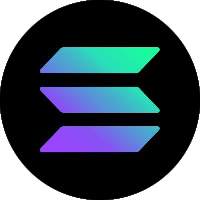Coinbase
Solana Nasıl Satın Alınır?
Müjde! Artık Solana, Coinbase'in merkezî takas platformu üzerinden satın alınabiliyor. Solana satın alımını sizin için kolaylaştırmak adına ayrıntılı talimatlar ekledik.
Devamını oku



En güvenli kripto takas platformunda Solana satın almak ve satmak için bir Coinbase hesabı oluşturun.
İlk satın alımınızı yaptıktan sonra ücretsiz kripto kazanın. Şartlar geçerlidir.

2021'de birden fazla Coinbase programı kapsamında (çekilişler hariç) kullanıcı başına tahminî ortalama tasarruf ve kazanılan ortalama ödülün toplamı. Bu tutara Coinbase One kapsamında alınmayan ücretler (abonelik ücreti hariç), Coinbase Card ödülleri ve staking ödülleri dâhildir.
Solana fiyatı son bir saat içinde %1,38 decreased ve son 24 saat içinde %6,75 decreased. Solana fiyatı geçtiğimiz hafta %11,37 risen. Güncel fiyat, 3,85 Mr $ tutarındaki 24 saatlik işlem hacmiyle SOL başına $146,81. Solana şu anda tüm zamanların en yüksek düzeyinin ($260,00) %43,53 altında değerleniyor. Bu, piyasaya sürülmesinden bu yana Solana için ödenen en yüksek fiyattır.
Solana varlığının dolaşımdaki mevcut arzı 447.041.295,616 SOL olduğundan Solana varlığının toplam piyasa değeri 447.041.295,616 olarak hesaplanıyor.
Ethereum Name Service (ENS) profilleri dünyasına göz atın. Bağlanmak, bilgi edinmek ve web3 topluluğuyla etkileşime geçmek için profile.coinbase.com adresini ziyaret edin. En popüler ENS profillerinden bazılarını aşağıda bulabilirsiniz.
Belirli içerikler, Coinbase Inc. veya onun iştirakleri ile ilişkisi olmayan üçüncü taraflarca hazırlanmıştır. Coinbase bu tür içeriklerden sorumlu değildir. Coinbase, içerikteki herhangi bir hata veya gecikmeden ya da herhangi bir içeriğe bağlı olarak gerçekleştirilen eylemlerden sorumlu değildir. Sunulan bilgiler yalnızca bilgilendirme amaçlıdır ve yatırım tavsiyesi değildir. Bu bilgiler, belirli bir dijital varlığın satın alınması veya satılması ya da belirli bir yatırım stratejisinden faydalanılması yönünde bir tavsiye niteliği taşımaz. Coinbase belirli bir varlık için sunulan bilgilerin doğruluğu, uygunluğu veya geçerliliği konusunda herhangi bir beyanda bulunmamaktadır. Gösterilen fiyatlar sadece örnek amaçlıdır. Güncel kripto fiyatları ve ilgili istatistikler değişiklik gösterebilir. Sunulan veriler, Coinbase ve diğer kripto borsalarında takas edilen varlıkları yansıtabilir.